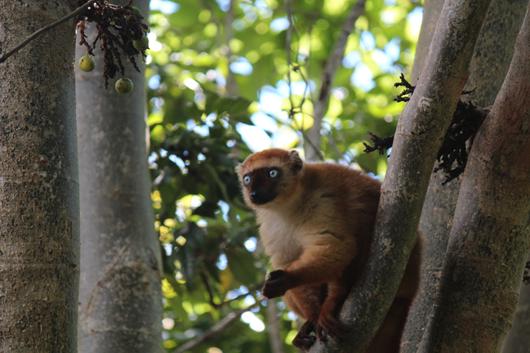Caitlin Eschmann
Hybridization of Critically Endangered Eulemur flavifrons with the much more widespread and common E. macaco has been reported in the Manongarivo Special Reserve of Madagascar, and is suspected elsewhere in its range. This study aims to contribute to conservation strategies by assessing the occurrence of hybridization through the analysis of the bioacoustics, social behaviours, and genomics of allopatric individuals and those living within the purported contact zone.

Female blue-eyed black lemur (E. flavifrons) in Ankarafa Forest.
As a result of an extensive population decline, the blue-eyed black lemur (Eulemur flavifrons) of Northwest Madagascar is arguably one of the most threatened lemur species. While the majority of research conducted on E. flavifrons has been restricted to the Sahamalaza Peninsula, there is a notable lack of knowledge concerning the remaining population of lemurs living inland. As the Andranomalaza River, which is thought to be the northern geographic barrier of E. flavifrons tapers off in the east, their distribution begins to overlap in a contact zone with the more abundant black lemur (E. macaco). Hybridization of E. flavifrons with E. macaco has been reported in the Manongarivo Special Reserve. These claims are based largely on morphological data, with no behavioural or genetic analyses yet undertaken. Hybridization is of conservation concern as it can result in the breakdown of premating isolation mechanisms and the loss of species-specific behaviours, ultimately leading to the loss of genetic integrity. This is especially worrisome for a species that is experiencing a rapid decrease in population size.
In this study we are investigating the extent of hybridization and determining levels of divergence or overlap in species-specific characteristics, while also suggesting whether reproductive barriers are still present in this area. The bioacoustics, social behaviours (with a strong focus on mating behaviours), and genomics of individuals living in the contact zone will be sampled to produce a holistic picture of the current extent of hybridization. Comparisons will be made to allopatric populations of E. flavifrons (Ankarafa Forest) and E. macaco (Ampasindava Peninsula) to determine the level of character displacement taking place within this region, as well as to identify whether there is a breakdown in reproductive isolation mechanisms that would normally prevent interbreeding. We will determine whether parental populations still remain in the area and how their characteristics may have changed due to this contact, thereby assessing the level of threat that hybridization may pose. These findings will inform a more accurate representation of distribution and abundance, as well as suggest key updates to the current management policies in place protecting this Critically Endangered lemur.